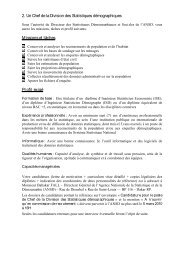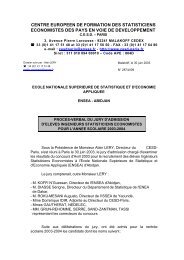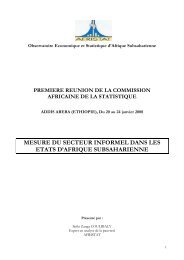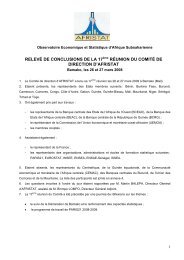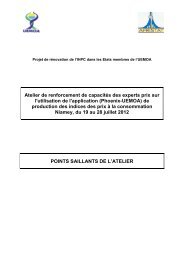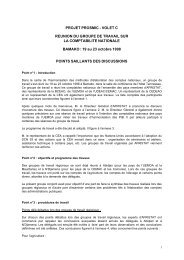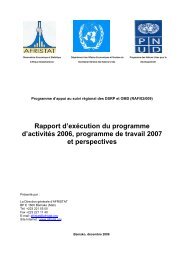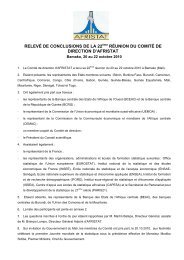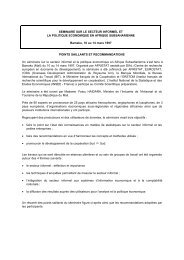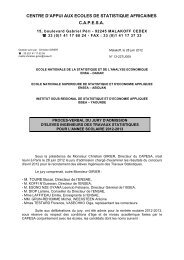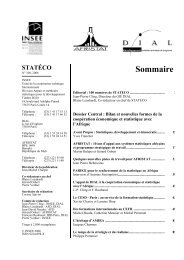Global Purchasing Power Parities and Real Expenditures - Afristat
Global Purchasing Power Parities and Real Expenditures - Afristat
Global Purchasing Power Parities and Real Expenditures - Afristat
Create successful ePaper yourself
Turn your PDF publications into a flip-book with our unique Google optimized e-Paper software.
160 <strong>Global</strong> <strong>Purchasing</strong> <strong>Power</strong> <strong>Parities</strong> <strong>and</strong> <strong>Real</strong> <strong>Expenditures</strong>Table 4Countries Included in the Ring ComparisonAfrica asia-Pacific Latin America Western Asia Eurostat-OECDCameroon Hong Kong, China Brazil Jordan EstoniaEgypt, Arab Rep. Malaysia Chile Oman JapanKenya Philippines SloveniaSenegal Sri Lanka United KingdomSouth AfricaZambiaSource: ICP 2003–2006 H<strong>and</strong>book.data-intensive <strong>and</strong> less resource-dem<strong>and</strong>ing than the ringcomparison. However, experience in previous rounds ofthe ICP showed that the results from using a single countrywithin each region to link the regions were too dependenton the economic structure of the bridge country. This wasa particular concern with so many new techniques beingused for the first time in the 2005 ICP. Any problems thatarose with a bridge country’s results would be reflected inthe relationship between all countries in that region <strong>and</strong>hence those in all other regions. The ring comparison wasdeveloped as a means of providing more robust links possiblebetween regions.The single exception was the Commonwealth of IndependentStates (CIS), whose regional results were linked tothe Eurostat-OECD region using Russia as a bridge country.Russia priced both the CIS <strong>and</strong> the Eurostat-OECDproduct lists to provide the link. The ring comparison wasused to combine the results for the other five regions. TheCIS countries’ results were then linked to those for theother regions using the relationship between Russia <strong>and</strong>the Eurostat-OECD region. In effect, the CIS results werelinked into the rest of the world in a two-stage process. Thefirst was using Russia as a bridge country. The second was alink to the other four regions using the relationships establishedby the Eurostat-OECD countries that participatedin the ring comparison. The main reason for using Russia asa bridge country was that this process was consistent withwhat had been used in recent rounds conducted by Eurostat-OECD,<strong>and</strong> the conceptual expertise <strong>and</strong> the practicalexperience required to enable this method to work wereavailable in the region.The following criteria were used to select ringcountries:m Having developed markets <strong>and</strong> an open economym Having a wide range of goods <strong>and</strong> services that werelikely to be found in ring countries in other regionsm Able to participate in the full GDP comparisonm Having acceptable price data <strong>and</strong> expenditureweightsm Able to derive annual, national average pricesm Willingness to act as a ring countryDeveloping the product list for ring countries was complicatedbecause it involved several different phases. Themost time-consuming part was preparing the product listfor consumer products. The starting point was to examinethe combined product lists across the regions <strong>and</strong> checkoff the products that each ring country had priced in theregional comparisons. Any products not priced by a ringcountry were discarded, while the remaining products wereretained as potential products to be included in the ringlist. The next stage was to check the structured productdescriptions (SPDs) for each of these products. The usefulnessof the worldwide SPD approach was evident in this



